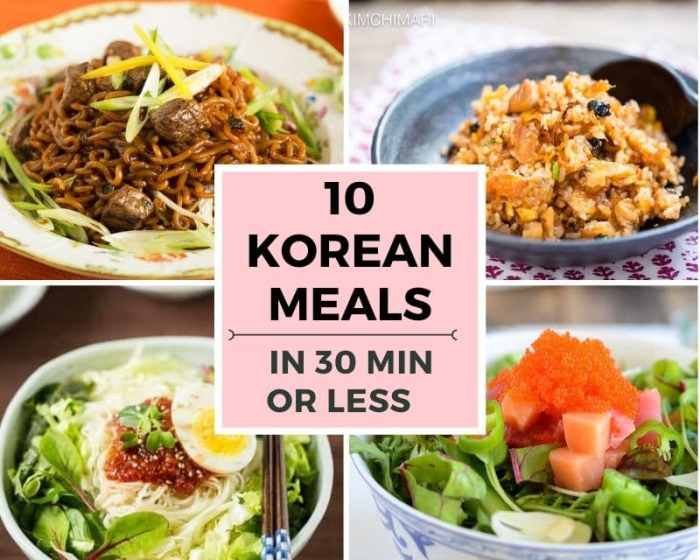How to cook korean style recipes – Are you ready to embark on a culinary journey to explore the vibrant flavors of Korean cuisine? Cooking Korean style recipes can be a rewarding experience that not only tantalizes your taste buds but also allows you to immerse yourself in a rich culinary tradition. As a professional writer, I am here to guide you through the process of creating delicious Korean dishes in your own kitchen.
Understanding Korean Cuisine
Korean cuisine is known for its bold flavors, colorful presentation, and emphasis on fresh ingredients. From spicy kimchi to savory bulgogi, Korean dishes are a harmonious blend of sweet, sour, salty, and spicy flavors. The key to cooking Korean style recipes lies in mastering the art of balancing these flavors to create a dish that is both satisfying and complex.
Tips for Cooking Korean Style Recipes
- Invest in quality Korean ingredients such as gochujang (red chili paste), doenjang (soybean paste), and sesame oil for authentic flavors.
- Marinate meat for a longer period of time to allow the flavors to penetrate and tenderize.
- Use a variety of vegetables and herbs to add depth and texture to your dishes.
- Don’t be afraid to experiment with different seasonings and spices to create your own unique twist on traditional recipes.
- Practice proper knife skills to ensure uniformity in cutting ingredients for even cooking.
What Do You Mean by Korean Cooking Techniques?: How To Cook Korean Style Recipes
Korean cooking techniques often involve stir-frying, grilling, braising, and fermenting. These methods help to enhance the natural flavors of the ingredients and create dishes that are both delicious and nutritious. By mastering these techniques, you can elevate your cooking skills and create restaurant-quality Korean dishes at home.
When it comes to preparing a delicious meal, mastering the art of cooking French-style lamb chops is a must. These tender and flavorful chops are a favorite among many food enthusiasts. If you’re looking to impress your guests or simply treat yourself to a gourmet experience, follow this step-by-step guide on how to cook French-style lamb chops for a delightful culinary adventure.
Known Korean Style Recipes
Some of the most popular Korean style recipes include bibimbap (mixed rice bowl), bulgogi (marinated beef), kimchi jjigae (kimchi stew), and japchae (stir-fried noodles). These dishes are beloved by Koreans and food enthusiasts around the world for their bold flavors and comforting appeal. By learning how to cook these recipes, you can experience the true essence of Korean cuisine.
Solution for Cooking Korean Style Recipes
To excel in cooking Korean style recipes, it is essential to familiarize yourself with Korean ingredients, cooking techniques, and flavor profiles. By honing your skills and experimenting with different recipes, you can develop a deep appreciation for Korean cuisine and create dishes that reflect your passion for cooking. With dedication and practice, you can master the art of Korean cooking and impress your friends and family with delicious homemade meals.
Detail Information on Korean Cooking
Korean cooking is a labor of love that requires patience, precision, and attention to detail. From preparing banchan (side dishes) to simmering soups and stews, every step in the cooking process contributes to the overall flavor and texture of the dish. By following authentic Korean recipes and techniques, you can recreate the flavors of Korea in your own kitchen and share the joy of homemade meals with your loved ones.
Describing Korean Cooking in Depth
Korean cooking is a celebration of simplicity and complexity, tradition and innovation. Whether you are grilling meat on a barbecue, fermenting vegetables for kimchi, or simmering a hearty soup, each dish tells a story of Korean culture and heritage. By immersing yourself in the world of Korean cooking, you can expand your culinary horizons and learn to appreciate the beauty of simple, wholesome ingredients prepared with care and passion.
Cooking Korean Style Recipes: Conclusion
In conclusion, cooking Korean style recipes is a fulfilling and enriching experience that allows you to explore the vibrant flavors and traditions of Korean cuisine. By following the tips, techniques, and recipes Artikeld in this article, you can embark on a culinary adventure that will delight your senses and nourish your soul. So gather your ingredients, sharpen your knives, and let the magic of Korean cooking inspire you to create delicious meals that bring joy and togetherness to your table.
Frequently Asked Questions
1. Where can I find authentic Korean ingredients for cooking?

You can find authentic Korean ingredients at Asian grocery stores, specialty markets, or online retailers that specialize in Korean food products.
2. Are Korean style recipes difficult to master for beginners?
While Korean cooking techniques may seem intimidating at first, with practice and patience, beginners can learn to cook delicious Korean dishes with confidence.
3. What is the best way to learn about Korean cooking?, How to cook korean style recipes
One of the best ways to learn about Korean cooking is to follow reputable Korean food blogs, watch cooking tutorials online, and attend cooking classes that focus on Korean cuisine.
4. Can I substitute ingredients in Korean recipes if I cannot find the original ones?
While it is ideal to use authentic Korean ingredients, you can sometimes substitute with similar ingredients that are more readily available in your area without compromising the overall flavor of the dish.
When it comes to preparing a delightful French-style dish, mastering the art of cooking lamb chops is essential. To learn the secrets of creating mouthwatering French-style lamb chops, you can follow this guide on how to cook French-style lamb chops with precision and finesse.
5. How can I ensure that my Korean dishes are cooked to perfection?

To ensure that your Korean dishes are cooked to perfection, it is important to follow the recipe instructions carefully, taste and adjust seasonings as needed, and practice good cooking techniques to achieve the desired results.
